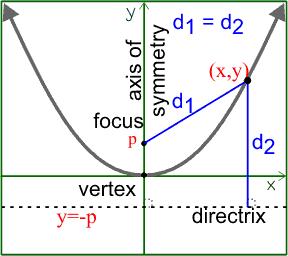
The conics get their name from the fact that they can be formed by passing a plane through a double-napped cone. There are four conic sections, and three degenerate cases, however, in this class we're going to look at five degenerate cases that can be formed from the general second degree equation.
The general form of a second degree equation is given by Ax2 + Bxy + Cy2 + Dx + Ey + F = 0
To determine the conic section by inspection, complete any squares that are necessary, so that the variables are on one side and the constant is on the right hand side. Any squared variable below could be replaced by a quantity. That is, instead of x2 + y2 = 1, it might be (x-2)2 + y2 = 1

A parabola is "the set of all points in a plane equidistant from a fixed point (focus) and a fixed line (directrix)".
The distances to any point (x,y) on the parabola from the focus (0,p) and the directrix y=-p, are equal to each other. This can be used to develop the equation of a parabola.
If you take the definition of a parabola and work out the algebra, you can develop the equation of a parabola. You can click on the link if you'd like to see the development, but the short version is that the standard form is x2 = 4py.
The parabola has the property that any signal (light, sound, etc) entering the parabola parallel to the axis of symmetry will be reflected through the focus (this is why satellite dishes and those parabolic antennas that the detectives use to eavesdrop on conversations work). Also, any signal originating at the focus will be reflected out parallel to the axis of symmetry (this is why flashlights work).
A circle is "the set of all points in a plane equidistant from a fixed point (center)".
The standard form for a circle, with center at the origin is x2 + y2 = r2, where r is the radius of the circle.

An ellipse is "the set of all points in a plane such that the sum of the distances from two fixed points (foci) is constant".
The sum of the distances to any point on the ellipse (x,y) from the two foci (c,0) and (-c,0) is a constant. That constant will be 2a.
If we let d1 and d2 bet the distances from the foci to the point, then d1 + d2 = 2a.
You can use that definition to derive the equation of an ellipse, but I'll give you the short form below.
The ellipse is a stretched circle. Begin with the unit circle (circle with a radius of 1) centered at the origin. Stretch the vertex from x=1 to x=a and the point y=1 to y=b. What you have done is multiplied every x by a and multiplied every y by b.
In translation form, you represent that by x divided by a and y divided by b. So, the equation of the circle changes from x2 + y2 = 1 to (x/a)2 + (y/b)2 = 1 and that is the standard equation for an ellipse centered at the origin.

A hyperbola is "the set of all points in a plane such that the difference of the distances from two fixed points (foci) is constant".
The difference of the distances to any point on the hyperbola (x,y) from the two foci (c,0) and (-c,0) is a constant. That constant will be 2a.
If we let d1 and d2 bet the distances from the foci to the point, then | d1 - d2 | = 2a.
The absolute value is around the difference so that it is always positive.
You can use that definition to derive the equation of a hyperbola, but I'll give you the short form below.
The only difference in the definition of a hyperbola and that of an ellipse is that the hyperbola is the difference of the distances from the foci that is constant and the ellipse is the sum of the distances from the foci that is constant.
Instead of the equation being (x/a)2 + (y/b)2 = 1, the equation is (x/a)2 - (y/b)2 = 1.
The graphs, however, are very different.
The table below summarizes the standard forms for the three main conic sections based on the direction of the main axis. For a parabola, the axis is the "axis of symmetry" and divides the parabola in half. For the ellipse, it's called the "major axis" and is the longer axis. For the hyperbola, the axis is the "transverse axis" and goes between the vertices.
| Horizontal Axis | Vertical Axis | |
|---|---|---|
| Parbola | ||
| Ellipse |  |
 |
| Hyperbola |  |
 |